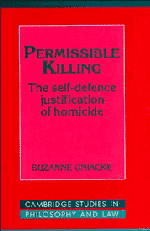Book contents
- Frontmatter
- Contents
- Acknowledgements
- Chapter 1 The problem of homicide in self-defence
- Chapter 2 Self-defence as a justification
- Chapter 3 Self-defence and natural law
- Chapter 4 The Double Effect justification
- Chapter 5 The right of self-defence
- Chapter 6 Self-defence and the right to life
- Bibliography
- Index
Chapter 6 - Self-defence and the right to life
Published online by Cambridge University Press: 01 March 2011
- Frontmatter
- Contents
- Acknowledgements
- Chapter 1 The problem of homicide in self-defence
- Chapter 2 Self-defence as a justification
- Chapter 3 Self-defence and natural law
- Chapter 4 The Double Effect justification
- Chapter 5 The right of self-defence
- Chapter 6 Self-defence and the right to life
- Bibliography
- Index
Summary
Something akin to a theory of forfeiture of rights is necessary to the justification of homicide in self-defence: it is necessary to the justification of self-preferential killing. Most philosophical discussions of justified homicide in self-defence maintain some variation of the claim that an unjust aggressor forfeits the right to life, but provide no more than a rudimentary theory of forfeiture. Nancy Davis, for instance, says that aggressors and assailants ‘have in some sense done something that has weakened, forfeited or undermined their prior claims to full moral parity with the persons who are now their victims’. Susan Levine assumes that an unjust aggressor's culpability would abrogate his or her moral standing compared with that of the victim.
The idea that human rights, such as the right to life and the right to liberty, can be forfeited is also frequently invoked in other contexts, most notably in justifications of punishment. The strong association of forfeiture of rights with punishment can wrongly suggest that, since an unjust aggressor forfeits the right to life, homicide in self-defence is justified as a punitive act. Certainly, some writers have taken the association of forfeiture of rights with culpability to mean that a unitary account of justified self-defence cannot invoke the idea of forfeiture: they assume that since only culpable aggressors can forfeit the right to life, self-defence against a morally innocent unjust aggressor either has a separate justification or is excusable homicide.
- Type
- Chapter
- Information
- Permissible KillingThe Self-Defence Justification of Homicide, pp. 194 - 231Publisher: Cambridge University PressPrint publication year: 1994



